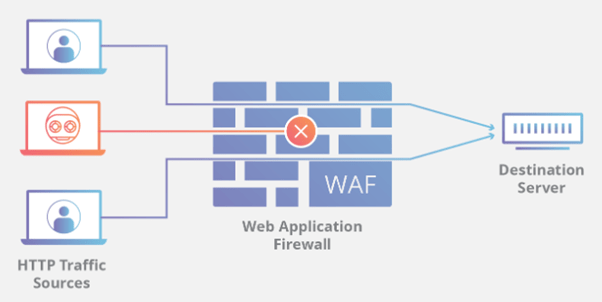Why we need a WAF?
Just as an online retail customer can interact with an online retail site, hackers can conduct malicious interactions as well. These attacks predominantly occur as SQL injections, cross-site scripting and malicious file executions. A modern day WAF is designed to protect against these and other OWASP Top Ten application risks. Azure WAF is able to discern fraudulent interactions from legitimate traffic. This is a highly complex task as hackers today weave their attack code within safe-looking website traffic. A WAF accomplishes this by intercepting and analyzing each and every HTTP request before they reach the web application.
WAF is also designed to perform SSL termination. Much of today’s web traffic is encrypted in order to protect the data being transferred within the web session. HTTPS works both ways however, in that it also protects malicious hacking code from being scrutinized as well. Many hackers take advantage of this, using HTTPS as a camouflage to avoid detection.
Because a WAF stands between the public and the web application, it is able to decouple the traffic between the web server and the internet. SSL certificates are hosted on the WAF, thus terminating the encrypted connection.

Use Cases:
1: Protect websites and applications
The primary function of a WAF is to protect applications that communicate over HTTP, including websites, API endpoints, and server less functions.
WAFs are the first layer of defence for the web. They can detect and block known and unknown attacks, lock down insecure systems, prevent data leaks, control access to URLs and ports, and mitigate the risk of inadequately configured servers.
A WAF provides all the benefits of a regular network firewall and more. It can detect advanced attacks such as the ones described in the OWASP Top 10 Threats list, enforce security policies, and ensure SSL security mechanisms.
2: Comply with security and regulatory standards
While threat prevention is the primary use case for a WAF, it’s not by any means the only one. Any website that processes or stores credit card data must comply with the Payment Card Industry Data Security Standard (PCI-DSS). Non-compliance can have grave consequences; breaches or credit card frauds in uncertified systems are heavily fined.
PCI-DSS mandates that websites must pass a security assessment (Requirement 6.6). The requirement can be fulfilled either by a code review—which can be expensive—or by setting up a WAF. Adopting a WAF can be the quickest and most efficient way to comply with regulatory requirements.
3: Control bots and prevent DDoS attacks
Bots are taking over. A third way in which WAFs can help us is by controlling their access to our systems.
On the Internet, there are good bots and bad bots. The good ones are fundamental for keeping things working. The bad ones will try to scrape content from websites, send spam, steal information, install malware, abuse APIs, brute force passwords, or initiate a DDoS attack.
Bots can cause damage by amplifying the effect of exploits or by over-utilizing resources and causing unexpected costs. WAF can block repeated access from bots with fine-grained rate limits and CAPTCHA rules.
4: Patch vulnerabilities
No code is perfect. Despite the best efforts to secure an application, there will always be some chance of vulnerabilities sneaking into production. When that happens, it can take some time until a solution is found and a patch is released.
The situation is even worse when a third party owns the code. Some vendors can take several days or weeks to release a patch. For instance, WordPress, the most popular CMS platform in the world (and the most hacked), releases security patches on a monthly schedule. Some of its plugins can have even more infrequent release schedules.
Unmaintained code is another problem altogether. When the source is no longer available, there is no way to patch it. In such cases where there is no suitable alternative, a WAF can be the only way of securing and locking down these systems.
5: Detect intrusions in real-time
Administrators and security teams have to keep track of traffic in real-time to detect attacks and act accordingly. On distributed systems, this is difficult because logs are scattered among many heterogeneous interfaces. Oftentimes intrusions are only detected hours or days after taking place.
A WAF acts as a central point of logging and metrics collection, with a particular focus on security. Administrators can monitor traffic, detect attacks in real-time, and take appropriate actions. WAF logs are also vital for diagnosing and assessing previous attack attempts.
